
CHAPTER 7 - BASICS
MODULATION
Basics of Modulation
Following is a description of some of the basics of modulation (i.e. key change) for those readers who would find this useful before reading the main text of this chapter. During the course of this description I will also highlight some of the arguments for viewing modulation in terms of chord progressions rather than the more conventional approaches which are based around a description of pivot chords, or degrees of relatedness between keys.
Modulation is the process that pieces of music go through to change the tonal centre from one key note to another. For example, a piece of music may modulate from C major to G major so that G takes over (albeit temporarily) from C as the keynote.
Modulation is central to compositional technique in classical music but to a lesser extent in modern popular music. Much has been written in composition text books, harmony books and theoretical texts about modulation, probably because the process of key change is reasonably well understood as it is a consciously learned process for composers. This contrasts with the organisation of chord progressions into syntactic structures which is largely subconscious. See the section on linguistics for further discussion on this topic.
The purpose of modulation is to help give music structure, direction and variety. The distance of the key change varies between periods in musical history and from composer to composer. The length of the stay in each new key can also vary considerably from a brief stop off (sometimes referred to as transient modulation or tonicization) to a whole section in a new key (sometimes referred to as transposition although this can also mean the transfer of a whole piece into a new key). Sometimes pieces can pass through several keys before settling on a new key centre or returning to the home key.
Modulation in a piece is often associated with the formal structure of a piece. A piece in a major key often modulates to its dominant key and there is often a cadence in the dominant at the end of the first section of the piece. For example, a piece starting in C major often ends its first section with a cadence in G major. The second section of a piece then takes the music back to the tonic key either directly or via other related keys.
Pieces in the minor key often move to a cadence in the relative major key at the end of the first section. For example, a piece in A minor may end its first section with a cadence in C major. The second section then takes the piece back to the original tonic key.
Modulation and the Pivot Chord
Most basic teaching on the process of modulation concentrates on the role of the pivot chord. A chord is chosen which is common to the two keys involved. The chord is ambiguous and takes on one function in the first key and is reinterpreted as a chord on a different degree of the scale in the new key. For the chord to be truly ambiguous then it should be neither the tonic nor dominant of either key. This process smoothes the flow from the first key to the second key. An outline of this would be as follows:
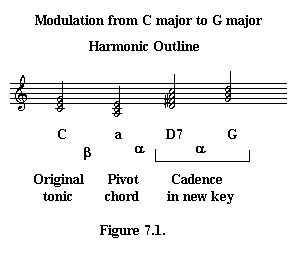
In this harmonic outline, the A minor chord is common to the keys: C major and G major and consequently can be used to smooth the transition form one key to the other. The A minor chord is moved to as chord VI in C major and quit as chord II in G major. This idea assumes that the mind perceives chords differently in relation to the keys preceding and following the chord. This is only an assumption.
An alternative interpretation is to say that the mind understands this example as a chord progression made up of one falling third (β) progression and two rising fourth (α) progressions. We will return to this issue later. An example of this progression is given in Example 7.1. in the main section of this chapter.
The modulation from the tonic to the dominant key is one of the most common modulations in tonal music. The piece normally returns to the tonic key either directly or indirectly via other related keys. By the theory of pivot chords this return could be made using the same common chord as follows:
G - A minor - G7 - C
However, this produces a poor chord progression because the static harmony pattern: G [ A minor ] G7 does not produce a feeling of movement (back) to the key of C major. More commonly, composers use a more direct chord progression by converting the G directly to a G7 chord as follows:
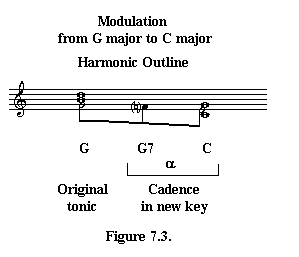
This introduces one of the alternative methods of modulation: the direct
movement to the new dominant chord. This method is frequently used
by composers and no smoothing pivot chord is used. Whilst it is certainly
useful to understand the use of pivot chords in modulation, this example
highlights one of the problems of a view of modulation which is based
on pivot chords. That is, it assumes that composers want to avoid the
juxtaposition of chords from different keys to avoid some kind of un-smooth
effect. However, actual practice shows that composers frequently use more
direct ways of making key changes. In fact, chromatic juxtapositions are
frequently used, even when no modulation is involved, so it would be strange
if they were to avoid these where modulation is involved. Rather
than trying to smooth the change from one key to another, composers frequently
use chromatic juxtapositions as a feature to relish rather than avoid.
A better view of the process of modulation is to consider the chord progressions
involved. The types of chord progressions that composers use are discussed
in the main section of this chapter.
Modulation - Key Relationships
Another way of describing modulation between keys is to describe the relative distance from one key to another via the cycle of 5ths. The cycle of fifths is a sequence of notes, a perfect fifth apart from each other, as follows:
![]()
In equal temperament, G-flat is the same note as F# so the sequence forms a complete cycle. A step to the right in this sequence involves the addition of a sharp (or removal of a flat) from the key signature. A step to the left involves the addition of a flat (or removal of a sharp) from the key signature.
Up to the 18th century, modulation was generally to the most related keys. That is, the adjacent keys in the cycle of 5ths and their relative minors. This is partly a result of the taste of the time but also because of the limitations of the tuning of instruments.
By this method, the relationship between the home key and its closest relatives can be shown as follows:
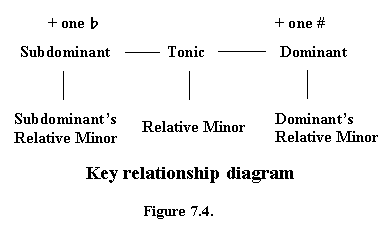
The dominant is
a fifth higher than the tonic and its key has one more sharp (or one less
flat), the subdominant
is a fifth lower than the tonic
and its key has one more flat (or one less sharp). The minor keys are
the relative minors of these keys. (i.e. the minor keys with a tonic a
third lower and which have the same key signatures).
In C major this would be:
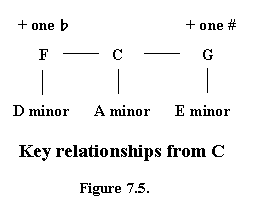
For an example of how to use this table in practice, please refer to the Example Harmonisation Section of this website.
These are the most closely related keys for several reasons:
- The tonic chords of all of the five related keys (and only these) are contained within the scale of the home key.
- All five keys are contained within the closest key signatures to the tonic. For example, C major and A minor have no accidentals; G major and E minor have one sharp and F major and D minor have one flat. This means they are all the keys that can be reached with just one change of accidental in the key structure.
- These keys all have chords in common with the home key. In the following table, I've shown these common chords (taking the minor keys in their harmonic form):
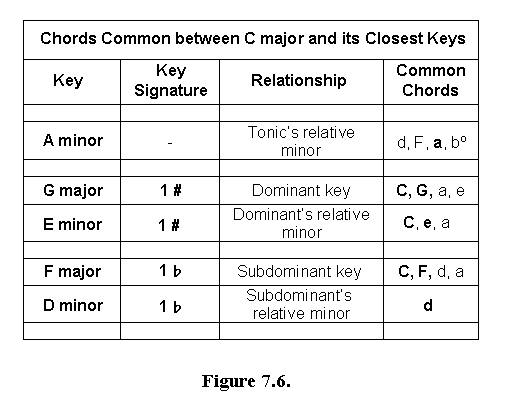
The chords shown in bold are chords which are either tonic or dominant chords of either the starting key or the key moved to. Therefore the non-bold chords are the best to use as a pivot chord. Note that the modulation from C major to D minor does not have a common chord that is not the tonic or dominant of either key. The best modulation here is to go direct to the dominant chord of the new key. This would be:
C - A7 - D minor.
This is an example where the pivot chord idea breaks down. See the main section of this chapter for more information about the 'direct to dominant' method of modulation.
Following is a corresponding chart of the common chords that can be used when modulation from a minor key (A minor used in the example). Again, I've taken the minor keys in their harmonic form. This chart shows that the availability of common chords is more limited than it is for modulations from the major key.
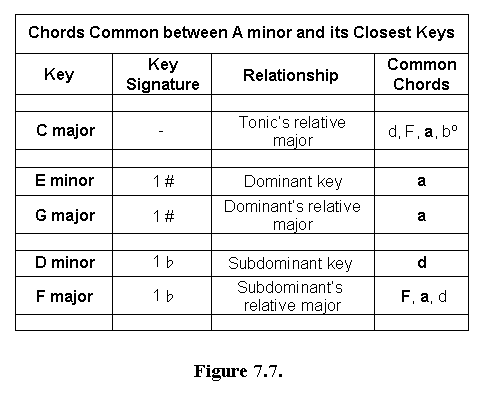
Only modulations to C major and F major have common chords which are not the tonic or dominant of either key involved in the modulation. This highlights again the need for an understanding of the process of modulation based on chord progressions rather that the use of pivot or common chords.
The key relationships described so far, were the most commonly used for modulations up until around the mid 18th century. The general adoption of equal temperament method of tuning and developments in musical instruments, gradually from the 18th century onwards meant that all keys were equally in tune and modulation to more distant keys became possible.
Some writers such as Schoenberg in Structural Functions of Harmony (see bibliography) have highlighted the relationship between a major key and its tonic minor. For example: between A major and A minor. This also opens up other possible modulations indirectly via this relationship. However, a description of these relationships is beyond the scope of this section and is not necessary in order to understand how chord progressions are used in making these key changes. Please refer to the bibliography for further reading on this.
Summary
A study of modulation based on common chords (pivot chords) is a useful starting point in the understanding of the process of modulation but, in practice, composers use a variety of techniques for modulation and a better understanding can be made of this subject by studying the chord progressions used. The main body of this chapter will proceed on this basis.
Ver 2.4a

